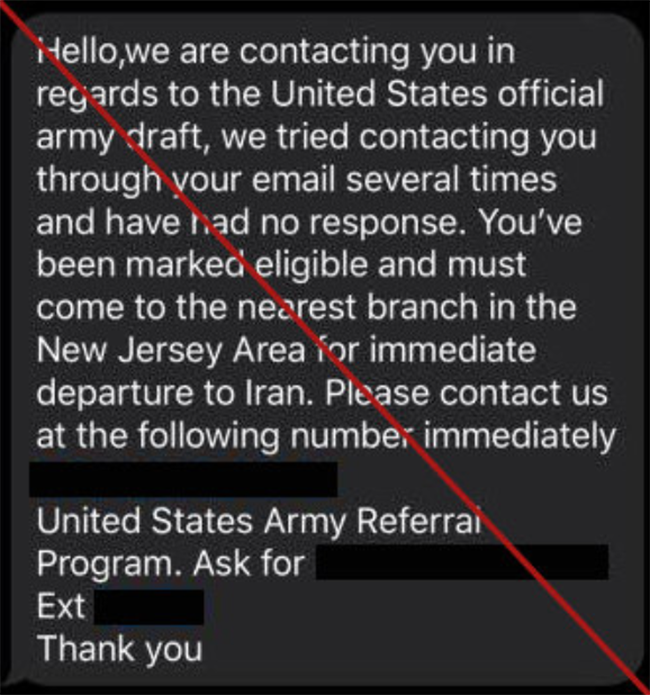
Photo Caption: A screenshot of the fake text. photo courtesy of The New York Times
Fake texts circulating the community brought fear to many Americans that they would be drafted in a potential war.
The new decade has been off to an eventful start, particularly with foreign affairs. On January 3rd, President Donald Trump called for a drone strike that killed Iranian General Soleimani and sent the two nations into a squabble. The following weeks consisted of back-and-forth threats and accusations, ultimately leading to Iran withdrawing from the United Nations’ nuclear deal and presenting a declaration of war. Social media and propaganda sent many Americans into a state of panic over a potential war. Rumors began to circulate that the draft, which has not been in effect since 1973, would be utilized again. The fear manifesting itself among Americans became unmanageable when a frenzy of fraudulent texts were sent out on January 8th. Individuals across the nation received these messages calling for “immediate departure to Iran.”
The ongoing tensions between the United States and Iran has left the youth in America preoccupied with the fear of being drafted or living in a war-zone. The texts appear to prey upon that fear due to the individuals targeted by this fraud. Although a draft hasn’t been used in almost five decades, the fear isn’t completely irrational. All male U.S. citizens (ages 18-25) residing in the United States, including immigrants (documented or undocumented), are required by law to register with Selective Services for a potential draft. Avoiding doing so could result in a fine as extreme as $250,000 along with time in federal prison. The cost of missing a portion of life to unwillingly serve is too high for many people. Many youth feel as though a life-changing decision is being made for them against their will. Sophomore Lauren Simasko explains “It’s not fair to expect every citizen to pack up and leave to defend the country because some people wouldn’t be fit to defend our country. It’s such a big task that only some are willing to do.” After considering her reaction to receiving a text claiming she was being drafted, Simasko proceeded to say, “I would probably be really scared because I would have to leave my family and friends and my life would be completely changed.” One of the antagonizing messages wound up on the phone of a 14 year old girl, far below the eligible age for a military draft. Nonetheless, the text seemed to be just as daunting for this girl as it would be for Simasko.
The unknown figure behind this prank is anything but harmless. They exposed children to the idea of a childhood without innocence. The instant one was to read that text, the thought of having to leave their entire family behind before full maturity is terrifying. Potentially lowering their own life expectancy without consent by going to war is unreasonable. The draft also constitutes risking a future with post traumatic stress disorder (PTSD), a prominent mental illness among veterans that can be difficult to manage, and so much more. It should be easier to say ‘no’ when faced with such a metamorphic decision, however, options are limited. Many physical and mental disabilities impair one from being drafted. Being transgender is also a reason to not be drafted. Aside from these major qualities and a few other exceptions, avoiding the draft is nearly impossible and can be faced with severe consequences. Not all people view the draft an ominous threat, rather as a moral obligation. Matthew Nicolo, the marketing teacher and DECA advisor at TJ, shares that “it is the basic civic duty of any citizen of a country to serve in protection of it, so if somebody were to avoid it based on not wanting to go, I think that there should be some repercussions to that effect.” Ultimately, the draft is currently dormant and not in use. Laws exist that prohibit the implementation of the draft, unless it is the only option for the nation’s security. There is nothing to fear at this point in time, but these fears and concerns were very real for people in 1973 when the draft was in effect. People should do their best to not believe everything they see on their phones; fake news is meant to generate reactions within people. Do the research so a fraudulent text won’t control a irrational fear.